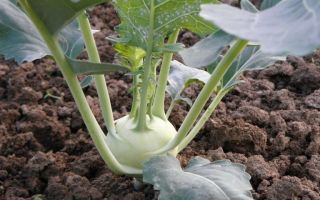Content
- 1 Composition and calorie content of kohlrabi
- 2 Why is kohlrabi cabbage useful?
- 3 Kohlrabi for weight loss
- 4 Kohlrabi during pregnancy and breastfeeding
- 5 At what age can kohlrabi be given to children
- 6 The use of kohlrabi in traditional medicine
- 7 Kohlrabi face masks
- 8 How to cook kohlrabi cabbage
- 9 What to cook from kohlrabi
- 10 Is it possible to eat kohlrabi leaves
- 11 How to choose and store kohlrabi
- 12 Kohlrabi harm and contraindications
- 13 Conclusion
Kohlrabi Mediterranean cabbage is not like ordinary cabbage. The most valuable part of it is not the leaves, but the stem that resembles a round turnip, and the taste of the vegetable is very different from the taste of white cabbage. What are the benefits and harms of kohlrabi, and how is the product used?
Composition and calorie content of kohlrabi
The calorie content of Mediterranean cabbage is extremely low - only 44 calories per 100 g of fresh vegetable. Of this volume, 77% are carbohydrates, another 21% are proteins, and very little fat in kohlrabi - 1.2%. But cabbage has an incredibly valuable composition. It includes:
- a real vitamin complex - B1 and B2, E, K, A;
- nicotinic acid, or vitamin PP;
- vitamin C in huge quantities - kohlrabi contains more of it than even lemon;
- the elements cobalt, potassium, copper, molybdenum and sulfur, calcium and boron, phosphorus and magnesium;
- glucose and fructose, mainly imparting a pleasant sweetish taste to the product;
- valuable digestive enzymes.
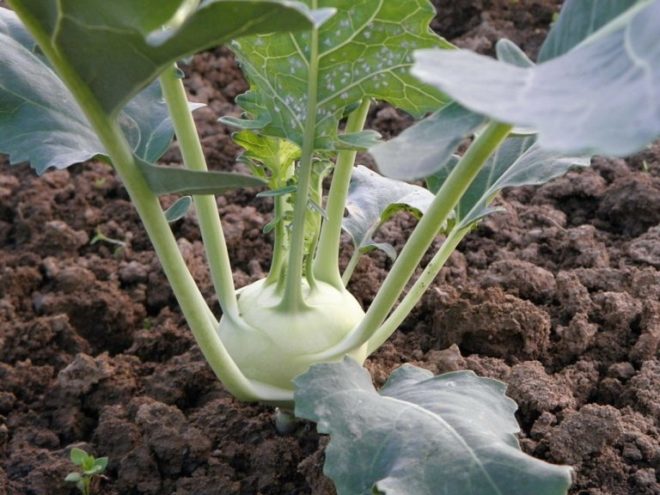
Why is kohlrabi cabbage useful?
The benefits of kohlrabi cabbage for the human body lies in the fact that the product has a beneficial effect on the most important systems and internal organs. In particular:
- prophylactically protects the body from oncology;
- improves the functioning of the intestines, stomach, liver and kidneys;
- helps to lose weight and further maintain a normal weight, since it effectively removes toxins and excess fluids;
- has a mild sedative effect and helps with anxiety;
- has antimicrobial and anti-inflammatory effect;
- strengthens the immune system;
- works well on blood vessels and the heart system.
Kohlrabi for weight loss
Due to the arginine substance in its composition, the product is an effective fat burning agent. If you include it in your diet, it will significantly speed up your metabolism, help to remove toxins and thereby help you say goodbye to excess weight faster.

Kohlrabi during pregnancy and breastfeeding
The use of Mediterranean cabbage while carrying a child is allowed - it contains a huge amount of vitamins that are beneficial for the mother and fetus. However, you should observe the measure when using the product, since excess cabbage can lead to flatulence and indigestion.
When breastfeeding, it is better to refuse the product - at least fresh. The vegetable has a lot of fiber, and this component provokes colic in infants. Allergic reactions are not excluded. It is better to introduce cabbage back into the diet no earlier than 3 months after the baby is born.
At what age can kohlrabi be given to children
It is allowed to give a vegetable to children after six months of life - preferably in processed form, boiled or baked, and in small portions.

The use of kohlrabi in traditional medicine
Vitamin Mediterranean cabbage is a huge benefit for the body in a wide variety of diseases. Traditional medicine uses kohlrabi to treat:
- diabetes mellitus;
- colds;
- heart, stomach and intestinal ailments;
- liver and kidney diseases;
- respiratory diseases.
Kohlrabi with honey for cholecystitis
Half a glass of fresh cabbage juice is mixed with 20 g of liquid honey and drunk shortly before meals. It is recommended to prepare such a drink twice a day, and the total duration of therapy is 2 months.
Kohlrabi to increase appetite
For appetite problems, fresh Mediterranean cabbage juice without any additives will help. It is taken in 1/3 cup half an hour before meals.

Colds and coughs
Cabbage juice drink is good for coughs and high fever. Mix 100 ml of fresh juice with the same amount of warm milk, add a teaspoon of honey and half a teaspoon of fresh onion juice.
You need to drink the remedy 2 tablespoons, 5 - 6 times a day, as soon as the first signs of a cold appear.
Kohlrabi for diabetes
It is possible to use the product for both types of diabetes only with the approval of a doctor - but in general, kohlrabi is an approved product. Mediterranean cabbage helps maintain body weight within the normal range, normalizes blood pressure and has a good effect on the walls of blood vessels. The product is well absorbed, since the glucose and fructose included in the composition do not give a sharp rise in blood sugar.

Prevention of cardiovascular diseases
Due to its vaso-strengthening properties, the product acts as an effective prevention of heart ailments. To take care of your heart, you can prepare and drink the following drink for a month:
- Mix 300 ml of kohlrabi juice with a couple of teaspoons of grapefruit juice;
- mix;
- take twice a day for 3-4 sips.
Pyelonephritis
With pyelonephritis, it is recommended to eat half a small head of kohlrabi every day, drinking the vegetable with plenty of water. You can also make a healthy healing salad:
- Wash 150 g of Mediterranean cabbage and green apple, finely chop and mix;
- Add 1 tablespoon of vegetable oil and some herbs to the salad.
You can eat such a salad every day, 1 or 2 times a day.
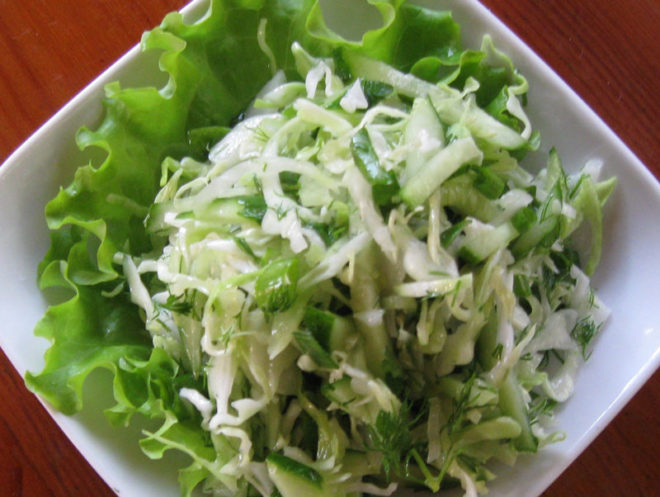
Gout
With gout, a drink made from kohlrabi, nuts and honey helps well. They do it like this:
- a glass of fresh cabbage juice is mixed with a large spoonful of liquid honey;
- add a little finely chopped walnuts;
- mix thoroughly.
It is best to take a drink in a couple of sips three times a day, no longer than a month.
Pancreatitis
With inflammation of the pancreas, any cabbage is quite dangerous - including Mediterranean. Fresh vegetables have an additional irritant effect on the gastrointestinal tract and may worsen the disease.
However, with the general good tolerance of kohlrabi with pancreatitis, it is allowed to use a little boiled or stewed cabbage. In this form, it will no longer harm the pancreas, but there will be benefits from vitamins and valuable elements in its composition.
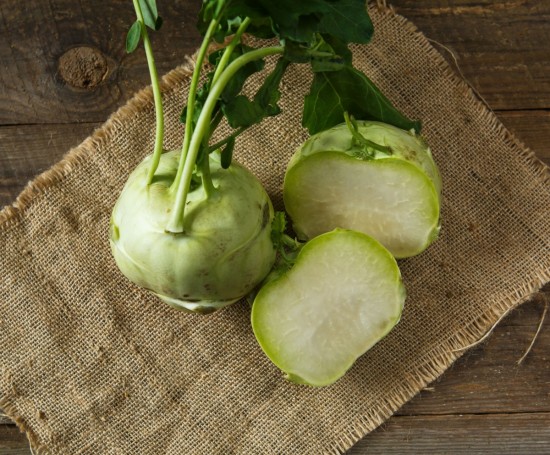
Bronchial asthma and tuberculosis
A great benefit from the product is observed in respiratory diseases - even with very severe ones. A decoction of kohlrabi leaves will help alleviate the symptoms of tuberculosis and asthma. They need to be poured with half a liter of water, boiled and boiled for 20 - 30 minutes, and then filtered and cooled.
When treating asthma, it is recommended to drink 3-4 sips of the broth twice a day. With tuberculosis, you need to limit yourself to 2 sips - but three times a day.
Kohlrabi face masks
Fresh kohlrabi cabbage has a wonderful effect on the skin of the face - it tightens it, eliminates fine wrinkles, tightens pores and relieves inflammation.
For example, to even out complexion and narrow pores, you can make the following mask:
- mix a small amount of fresh cabbage juice with egg yolk;
- spread the mask over the face and hold for 20 minutes;
- wash off with warm water.
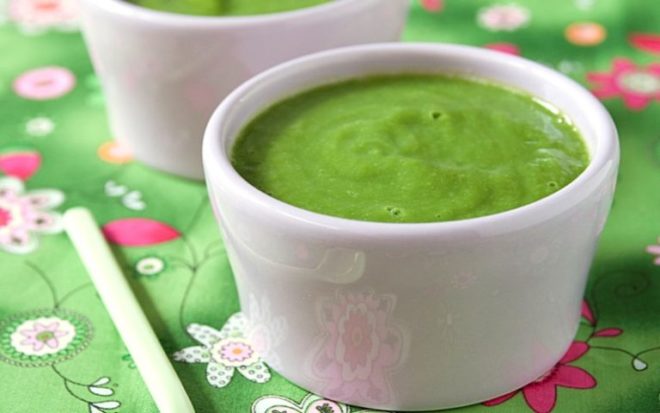
A different mask is used to moisturize and whiten the skin.
- Kohlrabi cabbage is rubbed on a fine grater, mixed with a similarly grated fresh cucumber.
- Then the mask is applied to the face and neck in an even layer.
- After 20 minutes, the mixture is washed off with warm water.
It is recommended to make masks based on kohlrabi weekly every 2 days - then the benefits will be maximum.
How to cook kohlrabi cabbage
The taste of this unusual cabbage is quite pleasant, so you can eat it fresh - especially since it retains maximum benefits in this way. But you can also process kohlrabi on fire - namely, boil, fry, bake or extinguish.
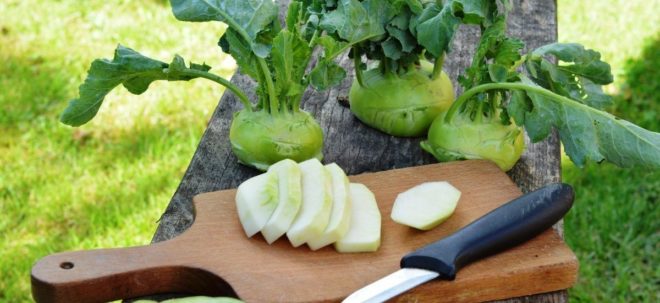
- It is customary to cook cabbage in chopped form, no more than 5 minutes - then the cabbage becomes soft, but its benefits remain.
- In order to fry kohlrabi, it is recommended to boil it first - a fresh vegetable acquires an unpleasant taste when frying. It is not accepted to fry the product for long, only until a golden hue appears.
- Cabbage is stewed over low heat for no more than 12 - 15 minutes. You can supplement the product with both other vegetables and meat products - cabbage will retain its benefits and give an unusual taste to familiar dishes.
- The vegetable can be baked in the oven using it as a primary or secondary ingredient. Before baking, the cabbage is washed and soaked in salted water for 15 minutes, and then placed in an oven preheated to 185 degrees. The cooking time depends on the specific dish.
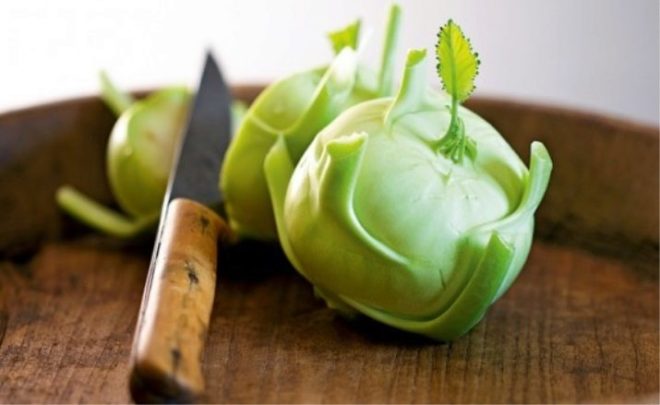
What to cook from kohlrabi
Kohlrabi is a product with a very wide range of applications. This cabbage is often found in:
- vegetable salads;
- regular soups and puree soups;
- second courses - meat or fish.
The product goes well with carrots and cucumbers, corn and green peas, apples and avocados, cheese and mushrooms. Boiled, stewed and baked cabbage is stuffed and added to stews, kohlrabi is used to make vegetable pancakes. Very tasty cabbage is obtained if you just fry it in batter and eat it as a separate dish.
Is it possible to eat kohlrabi leaves
Since the main benefit in most types of cabbage is in the leaves, when looking at kohlrabi, the question also arises - can the tops be used, or only the stem crop is used in cooking.
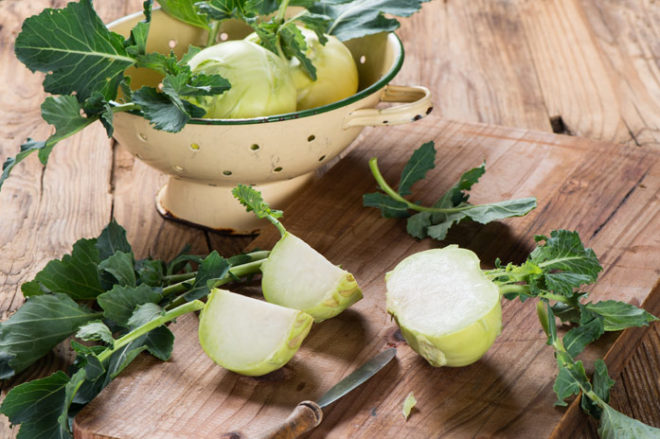
Kohlrabi leaves are suitable for use in the kitchen. And most importantly, they contain about 2 times more vitamins and nutrients than the stem crop. They can be freely added to salads, soups, meat dishes. But it is important that the leaves are fresh and not wilted, and they must be thoroughly rinsed before use. They are suitable for consumption both fresh and processed.
How to choose and store kohlrabi
When choosing cabbage, you need to be guided by only two rules.
- The most delicious and healthy kohlrabi is young. It can be recognized by its green, fresh leaves and small, strong stems. You should not buy old cabbage - its benefits are less, and the taste gives off a little wood.
- When buying, it is recommended to pay attention to the leaves of the vegetable. If they have small black dots, this indicates that kohlrabi was grown using nitrates.

Fresh cabbage is stored for a short time - a maximum of 3 weeks, even in the refrigerator. But at the same time, kohlrabi can be dried in the oven, having previously been cut into thin plates, or frozen, having boiled before that.
Kohlrabi harm and contraindications
For all its benefits, Mediterranean cabbage is contraindicated in certain diseases. Namely, you cannot use it:
- with acute pancreatitis and gastritis with high acidity;
- with exacerbation of a stomach or duodenal ulcer;
- with chronic hypotension;
- with an allergy to cabbage - it is not so rare.

You need to buy cabbage only in trusted stores, and if you have the slightest doubt about its quality, soak the vegetable before cooking in salt water and rinse thoroughly.
Conclusion
The benefits and harms of kohlrabi depend on the naturalness of the product - and on whether a person has chronic diseases from the list of contraindications. In all other situations, kohlrabi will benefit the body and will delight you with a pleasant taste.

